Featured image – Creative Commons License by GCBA
The piano is one of the most versatile instruments out there, so it’s no wonder that, throughout history, we have seen an array of musical geniuses take to the piano in orchestras, jazz bands, rock bands, and as solo performers.
If you’re looking to learn an instrument, the piano is a great place to start. But you might need some inspiration. So, whether you’re a budding musician or a piano aficionado already, our list of the most famous pianists will take you through the pioneers that have cemented the piano in many different genres, both traditional and contemporary. You’re bound to learn something new here!
In a hurry?
For the quick list, here are the five most famous pianists throughout history:
| Art Tatum |
| Chick Corea |
| Ludovico Einaudi |
| Martha Argerich |
| Ludwig van Beethoven |
The most famous pianists
1. Art Tatum (1909 – 1956)
Art Tatum, born in 1909, is celebrated as one of the greatest American jazz pianists. Renowned for his technical brilliance, Tatum transformed jazz with his complex harmonic sweeps and rhythmic shifts. His distinctive style featured innovative dissonance and heavy chord playing, setting new standards for solo piano performances.
Tatum’s improvisations, which showcased intricately woven melodies, continue to inspire jazz enthusiasts and pianists. His recordings are great to study if you want to understand jazz improvisation and technique.
2. Chick Corea (1941 – 2021)
Another revolutionary jazz pianist, Chick Corea profoundly influenced jazz fusion. His career began in the 1960s, in which he contributed to the development of jazz fusion with Miles Davis before forming his influential band, Return to Forever.
Corea’s playing style, characterised by his flawless technique and inventive compositions, blended jazz with rock, Latin, and classical influences. His compositions like “Spain” and “500 Miles High” are considered jazz masterpieces. Corea won 27 Grammy Awards and was nominated more than 70 times, cementing his legacy as a jazz icon.
3. Ludovico Einaudi (1955 – )
You’ll probably recognise Einaudi’s work for its delicate, flowing melodies and minimalist, contemporary classical approach.
Einaudi’s music has a certain meditative and ambient quality, and draws heavily on minimalism, blending classical forms with modern pop sensibilities. This unique fusion makes his work accessible and deeply resonant with a broad audience, which is why it’s been featured in many film scores and TV adverts!
His albums, such as I Giorni and Nightbook, and his project Seven Days Walking, reflect his exploration of the piano’s expressive range, joining the instrument’s classical potential with innovative, contemporary techniques. Einaudi’s music not only captures the essence of the modern classical genre but also continues to influence modern music today.
4. Martha Argerich (1941 – )
Martha Argerich, born in Buenos Aires, is a highly acclaimed classical concert pianist. She started playing the piano at age three and made her concert debut at just eight. In her early years, she won several prestigious competitions, such as the VII International Chopin Piano Competition in 1965.
Her distinctive playing style blends technical expertise with emotional intensity, especially in her interpretations of Chopin, Liszt, and Beethoven. She’s known for her work in concertos and chamber music, gaining international acclaim and numerous awards, including the Grammy Award and the Kennedy Center Honors.
5. Ludwig Van Beethoven (1770 -1827)
One of the most famous pianists in history, Ludwig van Beethoven, bridged the Classical and Romantic eras. Even after losing his hearing, he composed some of the most influential works in Western music, including the Ninth Symphony and late string quartets – making them even more remarkable.
Challenging in harmony and form, Beethoven’s pieces paved the way for a revolutionary approach to composition.
6. Jamie Cullum (1979 – )
A jump from classical music, Jamie Cullum is a distinguished British singer and pianist. His journey began with his album Heard It All Before, marking the start of what would be a vibrant and innovative career.
While Jamie is primarily known as a jazz artist, his music cleverly incorporates elements from a variety of genres, showcasing his versatility and broad musical tastes. He’s recognised for his rhythmic playing, usually by tapping rhythms on his piano or using stomp boxes whilst playing.
Cullum’s preferred instrument is the Yamaha S6 piano, on which he blends jazz with diverse musical influences, making him a unique figure in contemporary music.
7. Herbie Hancock (1940 – )
Herbie Hancock was born in Chicago in 1940. He showcased his impressive talent from a very young age, learning piano at just seven years old. Hancock was quickly recognised as a child prodigy, performing a Mozart piano concerto with the Chicago Symphony Orchestra by the age of eleven.
His professional career took off in the early 1960s, with his involvement in Donald Byrd’s group and, soon after, the legendary Miles Davis Quintet. Here, Hancock contributed significantly to the evolution of the post-bop sound. Hancock is known for his innovation, integrating elements of jazz fusion, funk, and electro into his music, influencing many future pianists.
Some of Hancock’s most popular works include iconic albums like Headhunters and influential tracks such as “Watermelon Man”. He has a dynamic approach to jazz and uses synthesizers to make his music distinctive.
8. Duke Ellington (1899 – 1974)
Duke Ellington, born Edward Kennedy Ellington in 1899 in Washington D.C., was a monumental figure in jazz history, renowned for his distinctive orchestral compositions and performances. Over his career, Ellington wrote thousands of compositions and was a driving force behind jazz’s growth into a sophisticated art form of great orchestral complexity.
His orchestra was famous for its luminous sound and how they mastered the nuances of jazz performance, making Ellington a pivotal figure in the evolution of big band music. Notably, his long tenure at the Cotton Club in Harlem propelled his career, influencing jazz and popular music worldwide.
Ellington’s innovative approach to music allowed him to craft intricate sounds, often blending classical elements with traditional jazz forms, which led to compositions like “Mood Indigo” and “Sophisticated Lady”. His legacy continues to influence countless musicians and composers, cementing his status as one of the greatest American composers and bandleaders.
9. Stevie Wonder (1950 – )
Whatever music you’re into, there’s no denying that Stevie Wonder is one of the most talented musicians of his time. Born Stevland Hardaway Judkins in Saginaw, Michigan, Wonder has been blind since infancy, but his mastery of the piano and other instruments was evident from a young age, leading to a contract with Motown at just eleven years old.
His style blends jazz, rock, and soul influences into a sophisticated melodic and rhythmic experience, highlighted by his use of synthesizers and innovative sound technologies.
From “Signed, Sealed, Delivered” to “Isn’t She Lovely”, Wonder’s songs skillfully blend catchy rhythms and complex arrangements. And they’ve stood the test of time; play “Superstition” at any party and people are bound to get up and dance. Stevie Wonder is a monumental figure in not only piano performance but also in the broader landscape of global music history.
10. Sergei Rachmaninoff (1873 – 1943)
Sergei Rachmaninoff was one of the leading figures of Romanticism in Russian classical music. A virtuoso pianist and composer, he entered the Moscow Conservatory as a child prodigy, gaining acclaim with his emotionally rich and technically demanding compositions.
His works, including the famous Piano Concerto No. 2 and Rhapsody on a Theme of Paganini, are some of the most emotionally rich, complex pieces of piano music.
11. Frederick Chopin (1810 – 1849)
Frédéric Chopin was one of the most popular Romantic composers and was celebrated for his solo piano works. His innovative compositions, including mazurkas, waltzes, nocturnes, and polonaises, showcased a unique blend of Polish folk music with classical traditions from Mozart and Schubert.
Chopin’s music, known for its technical complexity and expressiveness, reshaped the piano’s role both in concerts and private settings. Despite lifelong poor health, his contributions to music persisted, influencing not only the Romantic music era but also enriching the global repertoire with deeply personal and technically sophisticated compositions.
12. Lang Lang (1982 – )
Lang Lang, born in Shenyang, China in 1982, has revolutionised classical music with his dynamic playing style and his emotive playing. Educated at Beijing’s Central Conservatory and Philadelphia’s Curtis Institute, he became the first Chinese pianist to perform with the Vienna and Berlin Philharmonics.
Celebrated for his virtuosity and deep expressiveness, Lang Lang has broadened classical music’s appeal worldwide. His extensive discography and global concert performances have established him as a pivotal figure in bringing classical music to a contemporary audience.
13. Brad Mehlau (1970 – )
Jazz pianist Brad Mehldau is known for his intricate improvisations and blending of genres. Educated at The New School, he rose to prominence with Joshua Redman’s quartet and later through his influential trio.
Mehldau’s work integrates pop, rock, and classical influences into a jazz framework, showcasing his complex counterpoint and lyrical playing style. His acclaimed discography includes collaborations with Pat Metheny and notable albums like Largo.
14. Mary Lou Williams (1910 – 1981)
Mary Lou Williams, born in Atlanta in 1910, was a jazz pianist known for her dynamic style and significant contributions across jazz’s major movements. A child prodigy, she played with leading figures like Duke Ellington and Benny Goodman and was instrumental in shaping the bebop revolution. Williams composed and arranged pivotal pieces, mentoring giants like Thelonious Monk and Dizzy Gillespie.
Her work also extended to spiritual jazz compositions, reflecting her deep faith and social activism. Celebrated for her profound musical impact, Williams remains an iconic figure in the jazz world, noted for her resilience and creativity.
15. Thelonious Monk (1917 – 1982)
Thelonious Monk was a pioneering jazz pianist known for his distinctive playing style and contributions to the bebop genre. His approach to jazz included dissonances, angular melodies, and unusual rhythm and timing, which cemented his status as one of jazz’s greatest innovators.
Notable compositions like “‘Round Midnight” and “Blue Monk” are standards in the jazz repertoire. In fact, Monk’s legacy is so profound that he is the second-most-recorded jazz composer after Duke Ellington. His career accolades include a Grammy Lifetime Achievement Award and a special Pulitzer Prize.
16. Hiromi Uehara (1979 – )
Hiromi Uehara, born in Hamamatsu, Japan in 1979, is a distinguished jazz pianist and composer known for her electrifying performances and innovative compositions.
Hiromi’s style integrates elements of post-bop, progressive rock, classical, and fusion, reflecting her virtuosic command of the piano. Starting her musical education at six, she quickly advanced, performing with the Czech Philharmonic at 14 and collaborating with jazz legends like Chick Corea in her teens.
17. Khatia Buniatishvili (1987 – )
Khatia Buniatishvili is a Georgian concert pianist renowned for her expressive and technically accomplished playing style. Born in Tbilisi in 1987, she began her musical journey at just three years old, studying under her mother’s guidance.
After furthering her studies in Vienna, she signed with Sony Classical, releasing her acclaimed debut album, Franz Liszt, in 2011. Known for her emotive interpretations and virtuosic flair, Buniatishvili has a discography that spans composers like Chopin and Schubert, with her recordings consistently garnering praise for their depth and precision.
18. Yiruma (1978 – )
Yiruma, born Lee Ru-ma in 1978 in Seoul, South Korea, is an acclaimed composer and pianist known for his melodic piano compositions. Educated at King’s College London, Yiruma’s music often blends classical and modern characteristics, creating an emotive and accessible style that has resonated worldwide.
His breakthrough piece, “River Flows in You”, has achieved global recognition, and across Yiruma’s career, his compositions have topped international charts and his concerts are celebrated for their profound intimacy and grace.
19. Mitsuko Uchida (1948 – )
A conductor as well as classical pianist, Mitsuko Uchida is renowned for her interpretations of Mozart, Beethoven, and Schubert. Moving to Vienna at age twelve, she was immersed in rigorous musical training, leading to victories in prestigious competitions, including the Beethoven Competition in Vienna.
Uchida’s career is highlighted by her precise, expressive piano techniques and profound understanding of classical music, which have earned her multiple Grammy Awards and the honour of Dame Commander of the Order of the British Empire. Her performances continue to captivate audiences worldwide, securing her place as one of the most influential and famous female pianists.
20. Matt Bellamy (1978 – )
Matt Bellamy, Muse’s lead vocalist, guitarist, and pianist, has a dynamic playing style on the piano. As well as complex arpeggios, his playing fuses classical and modern influences. In fact, Bellamy often cites composers like Rachmaninov and Chopin as his influences.
Bellamy’s accomplishments with Muse include multiple Grammy Awards. With electronic and symphonic elements, Muse is one of the world’s most innovative rock bands. To achieve this sound, Bellamy uses the Kawai MP series stage piano in his setup.
21. Nina Simone (1933 – 2003)
One of the most inspiring female artists, Nina Simone’s jazz and blues performances on the piano have left a profound impact on music and civil rights. She teamed her piano playing with lyrics of love, pain, and racial injustice, as epitomised in her song “Mississippi Goddam”.
Simone originally aspired to be a classical pianist but went on to play jazz and blues. Her technical talent and expertise can be traced back to her studies of classical music, and you can really hear some of these influences shine through in her playing.
22. Fats Domino (1928 – 2017)
Fats Domino, born in New Orleans in 1928, was a pivotal figure in the birth of rock and roll. His debut “The Fat Man”, is considered one of the first rock and roll records and marked the beginning of a stellar career.
Known for his rolling piano style and warm vocals, Domino influenced the music industry profoundly with hits like “Ain’t That a Shame” and “Blueberry Hill”. He sold over 65 million records and was honoured with inductions into the Rock and Roll Hall of Fame and the Grammy Hall of Fame, cementing his legacy as a music icon.
23. Carole King (1942 – )
Carole King is one of the most influential singer-songwriters. Initially part of a songwriting duo with her then-husband Gerry Goffin, King wrote numerous hits during the 1960s.
Her transition to a solo artist brought her monumental success, particularly with her 1971 album, Tapestry, which remained on the charts for nearly six years, sold over 25 million copies worldwide, and won Album of the Year at the Grammys.
With the impact King has had on pop, folk, and soft rock, she has been inducted into the Songwriters Hall of Fame and the Rock and Roll Hall of Fame.
24. Myra Hess (1890 – 1965)
Dame Julia Myra Hess was an esteemed English pianist celebrated for her interpretations of Bach, Mozart, Beethoven, Schumann, and Brahms. Educated at the Royal Academy of Music under Tobias Matthay, Hess made her debut in 1907, quickly gaining fame across Europe and the United States.
She is particularly renowned for organising over 1,600 lunchtime concerts during WWII at the National Gallery, boosting morale during the London Blitz. Hess’ playing style combined technical proficiency with profound emotional depth, influencing generations of pianists.
25. Krystian Zimerman (1956 – )
Krystian Zimerman captivates audiences with his precise technique and deep expression through his music. He rose to international acclaim after winning the prestigious International Chopin Piano Competition in 1975, which set the stage for a career marked by collaborations with top orchestras and conductors worldwide.
Zimerman’s playing style is noted for its clarity, subtlety, and emotional engagement, particularly in his interpretations of Chopin, Beethoven, and Brahms. Zimerman is also a dedicated pedagogue and conductor, reflecting his deep commitment to music.
26. Glenn Gould (1932 – 1982)
Glenn Gould, born in Toronto in 1932, was a revolutionary Canadian pianist known for his unique interpretations of Bach. He gained fame with his distinct performance style and philosophical dedication to studio recordings.
Gould abandoned live performances at 31, preferring to focus on his recordings. His contributions to classical music were profound, influencing how music was appreciated.
27. Alicia Keys (1981 – )
Despite being an R&B artist, Alicia Keys soulfully blends classical and pop influences. Classically trained on the piano from a young age, Keys has been creating music since she was a child, leading to an early signing with Columbia Records. The piano plays a vital role in Key’s performances and song structures.
Her debut album, Songs in A Minor, was a commercial success, selling over 12 million copies worldwide and earning her five Grammy Awards, thanks in part to the hit single “Fallin'”. Throughout her career, Keys has continued to innovate and evolve her sound, garnering further acclaim and numerous awards, including 15 Grammy Awards.
Our piano recommendations
VISIONKEY–200 Digital Piano – great for beginners
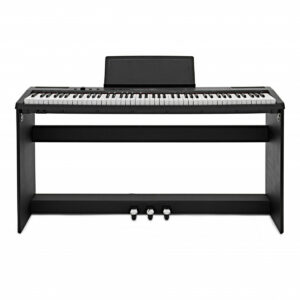 The VISIONKEY–200 is an excellent choice for beginner pianists who want an authentic and versatile playing experience with a digital piano. Its responsive key action mirrors the feel of an acoustic piano, providing a realistic touch that helps new musicians build proper technique.
The VISIONKEY–200 is an excellent choice for beginner pianists who want an authentic and versatile playing experience with a digital piano. Its responsive key action mirrors the feel of an acoustic piano, providing a realistic touch that helps new musicians build proper technique.
The weighted keys give each note a satisfying resistance, while the graded hammer action progressively lightens towards the higher registers, simulating the dynamics of a traditional piano.
This piano boasts a rich variety of features to support developing players, such as Bluetooth connectivity for playing along with online tutorials or recording practice sessions and a built-in metronome for honing timing skills.
The included 3-pedal stand provides standard sustain, soft, and sostenuto functions, offering complete control over your performance expression.
Additionally, the VISIONKEY–200 has a range of instrument voices and built-in effects that add a layer of creative potential, allowing you to explore different styles and sounds. Its compact design fits neatly into any home, while the robust, integrated stand ensures stability during practice sessions.
Casio AP-S450 Digital Piano – excellent for beginners & intermediate players
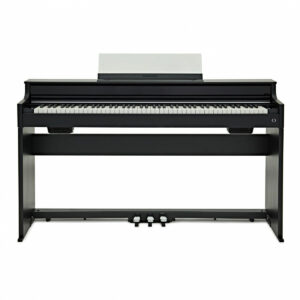 The Casio AP-S450 Digital Piano features the Smart Hybrid Hammer Action Keyboard that gives you a responsive, authentic feel similar to traditional pianos. Plus, the keys are crafted with high-quality resin, adding those extra premium details that elevate an instrument.
The Casio AP-S450 Digital Piano features the Smart Hybrid Hammer Action Keyboard that gives you a responsive, authentic feel similar to traditional pianos. Plus, the keys are crafted with high-quality resin, adding those extra premium details that elevate an instrument.
This elegant piano is a step up for any beginner and a fantastic option for more advanced musicians.
With 26 tones, including the striking Hamburg and New York Grand Piano sounds, the AP-S450 offers rich, immersive audio through its four-speaker system and two amplification channels. The speakers have been strategically placed to optimise sound projection.
The touch panel controls then make it easy to customise your sound. Located on the Visual Information Bar, these controls allow you to quickly access the ones you need, and they cleverly disappear when not in use – keeping the sleek aesthetic of the piano.
Better still, the compact, slimline design ensures that this piano is perfect for practice spaces of any size.
Casio GP510 Grand Hybrid Digital Piano – great for intermediate players
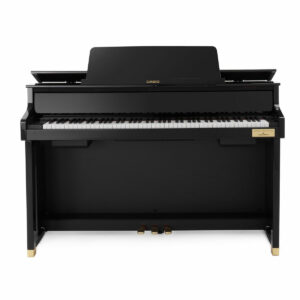 The Casio GP510 Grand Hybrid Digital Piano boasts an exceptional grand piano action, meticulously crafted in partnership with C. Bechstein.
The Casio GP510 Grand Hybrid Digital Piano boasts an exceptional grand piano action, meticulously crafted in partnership with C. Bechstein.
It’s a great piano if you want genuine touch and feel through grand hammer action keys. Through closely mirroring an acoustic grand piano, its high-quality action provides an authentic experience, allowing you to play with the proper technique you’d use on an acoustic piano.
Equipped with an enhanced speaker system, the GP510 produces a rich, room-filling sound. Its three distinctive grand piano tones are derived from meticulous sampling of Berlin, Hamburg, and Vienna grand pianos, offering diverse sonic palettes for varied styles.
The built-in Hall Simulator creates the acoustic atmosphere of iconic venues, adding immersive reverb to your playing.
There’s also Concert Play, which lets you practise alongside a virtual symphony orchestra. If you’re a beginner, the free Casio Music Academy provides online lessons to build confidence and skill.
With a headphone mode for quiet practice and versatile volume control, the GP510 is a comprehensive, supportive instrument for anyone.
Kawai CA901 Digital Piano – excellent for intermediate players
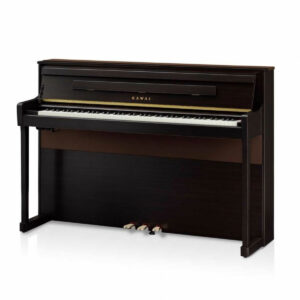 With Grand Feel III key action, the Kawai CA901 Digital Piano offers an exceptional playing experience. Its long wooden keys replicate a grand piano’s pivot mechanism, offering authentic touch and responsiveness.
With Grand Feel III key action, the Kawai CA901 Digital Piano offers an exceptional playing experience. Its long wooden keys replicate a grand piano’s pivot mechanism, offering authentic touch and responsiveness.
The triple-sensor system accurately detects nuanced key movements, while counterweights provide a balanced touch, enabling expressive performance and allowing for a range of playing techniques.
You then have the SK-EX Competition Grand piano sound engine, which blends multi-channel sampling with resonance modelling, delivering realistic tonal complexity.
And for great sound projection, there’s the new and improved Unique TwinDrive soundboard speaker system. This is made from real spruce wood and allows for rich, resonant, and organic sound – just like a traditional acoustic.
Bluetooth connectivity, an anti-glare touchscreen, and the Virtual Piano Artisan for detailed sound customisation are all included.
FAQs
Who is the most famous pianist?
The five most famous pianists are:
- Art Tatum
- Chick Corea
- Ludovico Einaudi
- Martha Argerich
- Ludwig van Beethoven
Who is the most famous pianist today?
Martha Argerich is considered one of the most famous pianists today. With her renditions of Chopin, Liszt, and Beethoven, she has amazed audiences with how technically precise and talented she is – which stems from her learning at the age of three and making her concert debut at the age of eight.
Who was considered the greatest pianist of the 20th century?
Art Tatum is regarded as the greatest pianist of the 20th century and is celebrated as one of the best American jazz pianists. He’s renowned for his technical brilliance, complex harmonic sweeps, and rhythmic shifts.
Final thoughts
The piano is a vital instrument in many genres, and our list of the most famous pianists shows just how many have shaped the musical landscape we know today, whether that’s in jazz, rock, or classical.
It’s one of the most popular instruments to play, and it works as a gateway to other instruments, take Matt Bellamy, for example, who started out learning piano before branching out to vocals and guitar.
Have we missed any other famous pianists? Let us know in the comments!

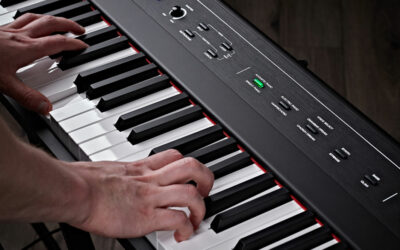
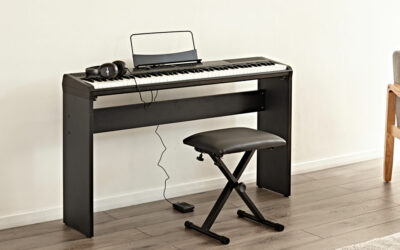
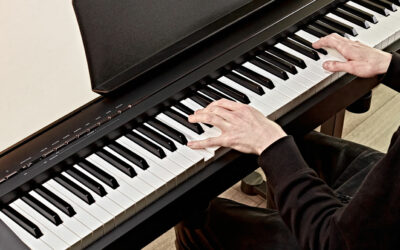

0 Comments